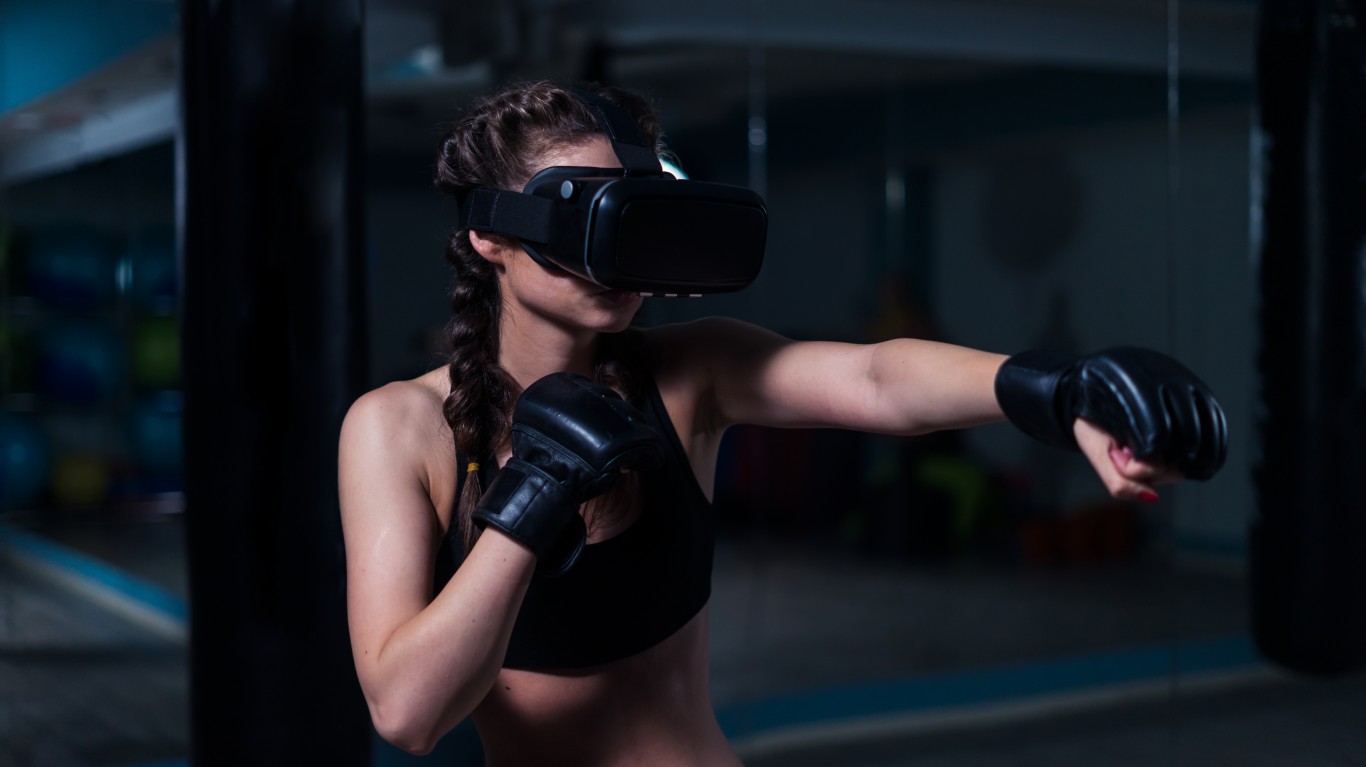Introduction Of Fitness Gaming

Hello to the immersive domain of fitness gaming, where enjoyment combines with physical activity to change the way you keep fit. This article looks at fitness gaming as a dynamic industry that has evolved, its health benefits, its and future possibilities. Watch how using gamification tactics can boost motivation and make it easier for people to get involved in wellness through an approach driven by a community. This is about unveiling fitness gaming as a force for change in redefining how we can remain active.
Section 2: Fitness Gaming Over Time

From when it started up until today, fitness games have come very far from being simple single-function games like “Pong’ or “Dance Dance Revolution” expanding their choice base by utilizing new technological developments in growing areas.
The birthplace of this digital exercise can be traced back to the first video game consoles that ever existed; Pong was among these initial gaming platforms that encompassed basic physical activity with paddle-controlled gameplay. Nevertheless, it took some time before any noticeable effect could be made on mainstream society through such titles as Wii Fit or Dance Dance Revolution. These games implemented motion-sensing technology and dance pads which furnished an interactive physical experience for players who wished to immerse themselves in virtual reality while playing (Huges n.p).
And then there was tech: As the technology evolved so did fitness games adapt advanced hardware that is based on augmented (AR)and virtual (VR) reality technology allowing users to engage in different levels of immersion in the h virtual environment and interact with digital elements in real-time. For example, Beat Saber and BoxVR are perfect cases for this trend because they provide exercise inside fascinating virtual worlds.
Similarly, wearable devices and gaming consoles integrated with fitness tracking features have enriched the experience brought by fitness gaming further. The latter has enabled gamers to check details like their heart rates as well as calories burnt during workouts at any particular moment hence acting as a means for feedback provision as well as motivation towards remaining active.
The future of fitness gaming is very bright, with advancements in technology that will continue to change the industry. It has endless possibilities from new ways of playing a game to more exciting sensory effects. No matter how much it changes, exercise gaming will still spark enthusiasm and influence individuals towards better lives.
Section 3: Health Benefits of Fitness Gaming

Meanwhile, there has always been a lot of attention being paid by various researchers in this area; hence it is evident that it has several positive implications as compared ed other forms of exercise making it a suitable selection for people of every age and physical status. By marrying entertainment and workouts through fitness games, these exercises become enjoyable and promote total wellness.
- **Cardiovascular Health**: Engaging in fitness gaming can significantly improve cardiovascular health by raising heart rate and increasing blood flow throughout the body. Games that involve dynamic movements, such as virtual sports or dance simulations, provide effective aerobic workouts.
- **Muscle Strength and Endurance**: Many fitness games incorporate resistance-based exercises that target various muscle groups. Developments like performing squats or lunges contribute to muscle development plus toning thus promoting overall physical fitness (Bissell n.p).
- **Improved Coordination and Balance**: Fitness gaming often necessitates specific moves and coordination patterns that improve motor skills as well as balance. Repetitive practice of such moves in a virtual world can help people become coordinated, thereby minimizing the risk of experiencing accidents or falls in everyday life.
- **Stress Reduction and Mental Well-being**: The immersive nature of fitness gaming makes it an appropriate platform for stress relief and relaxation. Playing games can make individuals forget all their worries and anxieties resulting in mental clarity and y, strength against emotions among other emotional challenges. Furthermore, exercise-induced endorphins enhance mood thus relieving depression and anxiety.
- **Social Connection and Support**: Nowadays multiplayer options are available on various fitness platforms enabling gamers to play together online as well as form support networks. In other words, they offer players opportunities to forge genuine relationships with each other through bonding over shared interests in gaming activities, building bonds between friends who compete against one another in virtual,y, or professional communities meant specifically for fitness gamers that are known to encourage thereby bolstering motivation levels.
Generally speaking, fitness gaming offers diverse health benefits cutting across physical wellness, well-being, and social affiliation issues among others. As a result, people can integrate fitness gaming into their lives to enjoy themselves while keeping fit and the benefits associated with this kind of healthier lifestyle.
Section 4: Popular Fitness Gaming Platforms

The increased popularity of health-related video games has led to the creation of countless platforms fitting different tastes and technical capabilities over the years. From console-based systems to mobile applications, there is a wide variety of choices when it comes to fitness gaming that caters to a large population.
- **Console-Based Platforms**: Amongst the various forms of entertainment developed are health games games console-game sector remains supreme with Nintendo Switch, PlayStation,n or Xbox having numerous titles targeting fitness lovers (Kucharczyk et al., p6). Nintendo Switch, for instance, has become famous with its motion-controlled joy cons and versatile gameplay titles such as “Ring Fit Adventure” and “Just Dance” that dominate the fitness gaming market.
- **PC and Virtual Reality (VR) Platforms**: PC game lovers who wish to have a true fitness experience can also try virtual reality (VR) platforms. Health and fitness games are available on VR headsets like Oculus Quest and HTC Vive, which allow users to experience immersive workouts within virtual reality while they explore incredible places. Some such games are Beat Saber as well as Thrill of the Fight; both have earned themselves a high reputation due to their innovative mechanics and the way they engage players in the game world.
- **Mobile Applications**: The popularity of digital video games among health-conscious smartphone and tablet users has been enhanced by the arrival of mobile devices. Games such as “Zombies, Run!” or “Pokemon GO” utilize augmented reality (AR), and location-based features to encourage physical exercise 24/7. Such applications make it easier to engage in fitness gaming while on the move or at home hence becoming so popular among many people.
- **Wearable Devices and Fitness Trackers**: Additionally there are dedicated gaming platforms that include wearable devices and fitness trackers in the setup for an enriched gaming experience. Devices such as those produced by Apple Watch, Fitbit, Garmi,n, etc., provide gamified fitness experiences; thus they monitor one’s body movements ireal-timeme while helping users set goals for improvement purposes based on their daily activity levels among others. Through this way of recording steps and other measures, these devices motivate users to keep exercising so that they can reach their ultimate aims concerning health issues or weight control
Fitness gaming platforms that are popular cater to various preferences and technological wants, thus providing individuals with the means to select the best-suited gaming experience for their needs and tastes. For those who own different devices such as consoles, PCs, mobile phones, or wearables, there is a wide range of fitness games available which make it possible for anyone to find an enjoyable and interactive way of staying in good shape.
Section 5: Gamification Techniques in Fitness
Gamification plays an integral role in improving motivation and engagement levels during fitness gaming while transforming dull exercises into exciting experiences with rewards. By introducing some principles of game design e.g., challenges, rewards,s and progression systems among other things, these fitness games hold player’s attention while keeping them on track over time.
- **Progression Systems**: Most fitness games employ progression systems that help players monitor their progress over time and set achievable targets. Players are motivated by meeting certain goals within certain times because they will be rewarded accordingly after completing them.
- **Challenges and Achievements**: Incorporating a sense of achievement and excitement into fitness gaming motivates players to push boundaries and try new things. For instance, one may have a challenge to complete several exercises during a particular week or even master complicated routine moves such as difficult yoga poses which motivate engagement within this group.
- **Social Interaction and Competition**: Several fitness games also include social aspects that enable users to interact with friends online through challenges or share achievements won in the game. These virtual interactions create friendly competition amongst peers leading them to work harder than their counterparts hence upholding motivation levels thus maintaining accountability.
- **Rewards and Incentives**: Rewards are given when players reach milestones like unlocking special items such as workout routines or clothes for avatars that can be earned through obtaining virtual badges or coins respectively thereby making gamers remain interested throughout their journey towards improving health status since they always look forward to achieving greater heights.
- **Feedback and Progress Tracking**: Feedback provision mechanisms including progress trackers, performance metrics, and real-time feedback during gameplay allow players to assess their performance and evaluate it against their workout goals. These mechanisms will give immediate feedback on skill development by correcting the player’s technique, form, and progress.
Ultimately, fitness gaming becomes fun, effective, and sustainable through gamification techniques. By using the principles of game design to enhance motivation, engagement, and adherence towards physical training efforts; these fitness games have become a great way for people to take charge of their health in an enjoyable manner that is also interactive as well.
Section 6: Fitness-gaming effectiveness
Fitness game effectiveness assessment is crucial as it helps in determining its impact on physiological health, mental ability, and general wellness. This can be established by user reports and scientific findings about the efficiency of fitness games as other kinds of workouts for instance.
- **Physical Health Benefits**: Several studies have shown that there are numerous physical health benefits (e.g., improvements in cardiovascular fitness, muscle strength,gth, and flexibility) of fitness gaming. For instance, a study found in the Journal of Sports Science & Medicine journal indicated that virtual reality fitness game players improved their cardiovascular endurance and balance more than the traditional exercise control group.
- **Motivation and Adherence**: One of the advantages of fitness gaming is that it can motivate individuals to exercise regularly and adhere to their fitness routines. Research has shown gamification aspects inherent in fitness games such as challenges, rewards, and social interaction enhance motivation and engagement leading to high levels of adherence and; hence long-term commitment to exercise.
- **Cognitive Benefits**: Fitness gaming offers cognitive benefits including memory enhancement, attention improvement as well and executive development besides being so beneficial for your body. In one study published in Frontiers in Human Neuroscience, exergames were seen to improve older adults’ cognitive functions suggesting that this avenue could be explored for addressing cognitive aging and dementia risk reduction.
- **Accessibility and Inclusivity**: By its characteristics, fitness gaming can become a tool for making exercising easily accessible even by those who may not be able to attend gyms or other specialized exercise facilities due to age, disability current level of physical condition, etc. On the contrary, people also have an opportunity to play some video games at home using either game consoles or mobile gadgets which are readily available today instead of going somewhere where they will need special equipment as well as other facilities limited only by imagination. Such availability removes barriers to training while enabling those who struggle with traditional gym settings to have a chance to do exercises.
- **Integration with Lifestyle**: Another point where fitness gaming is so effective is that it can fit into any user`s lifestyle, making it easier for people to engage in physical activity regularly. Whether you prefer customized workout regimens tracking your progress or in-game reminders, exergames help individuals create their own unique fitness experience which can be adapon the goe-go and at personal convenience.
In conclusion, fitness-gaming effectiveness goes beyond the domain of physical health encompassing motivation, cognitive function, accessibility, and lifestyle integration. By using gamification approaches as well as interactive technology, fitness gaming provides an attractive sustainable way of improving the overall health and well-being of people regardless of their age or origin.
Section 7: Inclusivity and Access in Fitness Gaming
The design and implementation of this game should take into account issues related to physical barriers that limit access as well as inclusivity. By removing obstacles to participation and catering to diverse needs and preferences, fitness gaming can reach a wider audience thus promoting inclusive access to physical activities.
1.**Physical Accessibility**: Fitness games provide various options for physically disabled people. Many games feature adaptive controllers combined with motion-tracking technology that enable players to tailor gameplay according to their ability levels; hence these persons get a chance not only to play them but also to win whatever they want regardless of their real capabilities. Further still are virtual reality (VR) platforms which empower users with immersive experiences irrespective of physical limitations such as walking difficulties thereby enabling them to perform actions that may appear difficult or even impossible in real-life situations.
2.**Cognitive Accessibility**: fitness gaming can be a supportive and engaging environment for individuals with cognitive difficulties or neurodivergent conditions. The games that offer clear instructions, visual cues, and adjustable settings fit different learning styles and cognitive abilities to ensure all can participate as well as benefit from exercising.
3.**Language and Cultural Accessibility**: Fitness gaming must consider linguistic and cultural diversity if it is to reach people in diverse parts of the world. Therefore, multilingual Games, have culturally relevant content and inclusive representation to promote engagement as well as resonance among diversified communities. Furthermore, games should incorporate various cultural references and celebrations so that players from different backgrounds may feel belongingness and inclusivity while playing.
4.**Financial Accessibility**: For the less fortunate individuals such as low-income earners who cannot afford fitness gaming experiences due to their huge costs they are always disadvantaged economically by this factor.. To curb this problem there should be available some affordable options such as mobile apps or browser-based that which are free-to-play to encourage them to join in. Additionally, community gaming centers or library programs that give access to those without money to buy themselves a game may also help in bringing game equipment closer to the public domain.
5.**Education and Training**: Education and training initiatives are crucial for ensuring accessibility of fitness gaming across diverse populations. Giving resources, guidance, and support to developers of these games, fitness professionals, educators, or medical service givers is one way of making sure we have made them ready for inclusivity in the gaming industry. Collaboration between one another on best practices is what will enable the industry to maintain its progress towards accessibility even further thereby making all people fully involved in fitness gaming.
Thereby reducing barriers through design implementation outreach that prioritizes accessibility(in terms of availability)and inclusiveness(everyone’s participation), fitness gaming could break down barriers so that everybody regardless of their capacities might become physically active whether engaged with it or not.in turn, embracing diversity and inclusion makes the games a more equitable, supportive environment for all players.
Section 8: Community and Social Interaction
Community and social interaction among players are key aspects of the fitness gaming experience, which build a sense of companionship, encouragement as well as motivation. By bringing together people from different backgrounds who live far apart from each other, fit gaming communities create belongingness and responsibility that enhance the overall fun and effectiveness of this sport.
1.**Online Communities and Forums**: Online communities and forums are often provided by fitness gaming platforms to enable players to connect, share experiences, or seek advice from fellow enthusiasts. Through these game spaces, online discussions on strategies for winning challenges can take place while others can be used to solve technical issues experienced during play while also congratulating participants’ achievements hence developing strong bonds between individuals.
2.**Multiplayer and Cooperative Gameplay**: Many fitness games feature multiplayer options where friends or even strangers team up to complete challenges towards achieving their fitness goals. Be it virtual races against each other or group workouts together; multiplayer gaming motivates one another since they work in teams to achieve commonly set targets.
3.**In-Game Events and Challenges**: In-game events and challenges are common features in fitness gaming that prompt players to participate in themed activities such as rewards or recognition competitions. These events range from virtual marathons held annually, sometimes only once including seasonal challenges leading to social interactions in line with healthy competition. This drives engagement among gamers thus making them feel like a community.
- **Streaming and Content Creation**: Fitness gamers have been able to share their experiences with others from different countries, thanks to the rise of live streaming platforms and content creation tools that exist in this digital age. Content creators play an important role in building and maintaining vibrant fitness gaming communities through online workout sessions, sharing highlights of their gameplay, or giving advice on how to do things.
- **Local Meetups and Events**: In the physical world, however, these communities often hold local meetups, events, and tournaments where people gather to socialize, network, work, and engage in friendly competition. These offline interactions strengthen bonds between community members and provide opportunities for face-to-face connection and support, complementing the online gaming experience.
In general terms therefore community and social interaction is a significant part of the fitness gaming ecosystem; that enhances player’s experience and contributes towards long-term engagement as well as adherence. Such communities foster belongingness thereby enabling followers to achieve fitness goals with comradeship among those who love similar activities as them.
Conclusion
Fitness gaming is thus a living example of how entertainment can be combined with exercise leading to various outcomes ranging from better body health to improved social relationships. Gamification initiatives on accessibility alongside thriving participation in communities have made fitness gaming appear like a more reasonable channel via which individuals can seek personal wellness in an enjoyable way accessible by all. Undoubtedly technology will continue shaping this theme but its scope cannot be ignored about how it could transform our approach to well-being through physical exercises.
